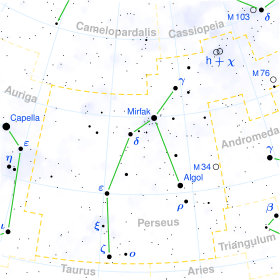X Persei
| Observation data Epoch J2000.0 Equinox J2000.0 | |
|---|---|
| Constellation | Perseus |
| Right ascension | 03h 55m 23.07715s[1] |
| Declination | +31° 02′ 450062″[1] |
| Apparent magnitude (V) | 6.778[2] (6.03 - 7.00[3]) |
| Characteristics | |
| Spectral type | O9.5IIIe-B0Ve[4] |
| U−B color index | −0.790[2] |
| B−V color index | +0.137[2] |
| Variable type | γ Cas + X-ray pulsar[3] |
| Astrometry | |
| Radial velocity (Rv) | −50.00[5] km/s |
| Proper motion (μ) | RA: −2.28[1] mas/yr Dec.: −5.42[1] mas/yr |
| Parallax (π) | 2.34 ± 0.70[1] mas |
| Distance | 950[6] pc |
| Absolute magnitude (MV) | −3.47[2] |
| Orbit[7] | |
| Primary | X Per |
| Companion | 4U 0352+309 |
| Period (P) | 250.3 days |
| Semi-major axis (a) | 2.2 AU |
| Eccentricity (e) | 0.111 |
| Inclination (i) | 23 - 30° |
| Details | |
| Mass | 15.5[8] M☉ |
| Radius | 6.5[8] R☉ |
| Luminosity | 29,000[2] L☉ |
| Surface gravity (log g) | 4.0[2] cgs |
| Temperature | 29,500[8] K |
| Rotational velocity (v sin i) | 215[2] km/s |
| Age | 5[2] Myr |
| Other designations | |
| A: X Per | |
| B: 4U 0352+309 | |
| Database references | |
| SIMBAD | data |
X Persei is a binary star system located in the constellation Perseus, approximately 950 parsecs away.
The optical star X Persei has been classified either as an O-type giant or a B-type main sequence star. It is a Be star, rotating rapidly, and at times surrounded by a disk of expelled material. This qualifies it as a Gamma Cassiopeia variable, and the visual range is magnitude 6 - 7. There is a faint optical companion separated by 22.5" which the Catalog of Components of Double and Multiple Stars refers to as X Persei B.[9]
X Persei A is in orbit with a neutron star, which is catalogued as 4U 0352+309 in the final Uhuru catalog of x-ray objects. It is a pulsar with an unusually long period of 837 seconds.[7]
References
- 1 2 3 4 5 Van Leeuwen, F. (2007). "Validation of the new Hipparcos reduction". Astronomy and Astrophysics. 474 (2): 653. arXiv:0708.1752
 . Bibcode:2007A&A...474..653V. doi:10.1051/0004-6361:20078357.
. Bibcode:2007A&A...474..653V. doi:10.1051/0004-6361:20078357. - 1 2 3 4 5 6 7 8 Lyubimkov, L. S.; Rostopchin, S. I.; Roche, P.; Tarasov, A. E. (1997). "Fundamental parameters, helium abundance and distance of X Persei". Monthly Notices of the Royal Astronomical Society. 286 (3): 549. Bibcode:1997MNRAS.286..549L. doi:10.1093/mnras/286.3.549.
- 1 2 Samus, N. N.; Durlevich, O. V.; et al. (2009). "VizieR Online Data Catalog: General Catalogue of Variable Stars (Samus+ 2007-2013)". VizieR On-line Data Catalog: B/gcvs. Originally published in: 2009yCat....102025S. 1. Bibcode:2009yCat....102025S.
- ↑ Valencic, Lynne A.; Smith, Randall K. (2013). "Interstellar Abundances toward X Per, Revisited". The Astrophysical Journal. 770: 22. Bibcode:2013ApJ...770...22V. doi:10.1088/0004-637X/770/1/22.
- ↑ Kharchenko, N. V.; Scholz, R.-D.; Piskunov, A. E.; Röser, S.; Schilbach, E. (2007). "Astrophysical supplements to the ASCC-2.5: Ia. Radial velocities of ˜55000 stars and mean radial velocities of 516 Galactic open clusters and associations". Astronomische Nachrichten. 328 (9): 889. arXiv:0705.0878
 . Bibcode:2007AN....328..889K. doi:10.1002/asna.200710776.
. Bibcode:2007AN....328..889K. doi:10.1002/asna.200710776. - ↑ Walter, Roland; Lutovinov, Alexander A.; Bozzo, Enrico; Tsygankov, Sergey S. (2015). "High-mass X-ray binaries in the Milky Way. A closer look with INTEGRAL". The Astronomy and Astrophysics Review. 23: 2. arXiv:1505.03651
 . Bibcode:2015A&ARv..23....2W. doi:10.1007/s00159-015-0082-6.
. Bibcode:2015A&ARv..23....2W. doi:10.1007/s00159-015-0082-6. - 1 2 Delgado‐Marti, H.; Levine, A. M.; Pfahl, E.; Rappaport, S. A. (2001). "The Orbit of X Persei and Its Neutron Star Companion". The Astrophysical Journal. 546: 455. arXiv:astro-ph/0004258
 . Bibcode:2001ApJ...546..455D. doi:10.1086/318236.
. Bibcode:2001ApJ...546..455D. doi:10.1086/318236. - 1 2 3 Grundstrom, E. D.; Boyajian, T. S.; Finch, C.; Gies, D. R.; Huang, W.; McSwain, M. V.; O'Brien, D. P.; Riddle, R. L.; Trippe, M. L.; Williams, S. J.; Wingert, D. W.; Zaballa, R. A. (2007). "Joint Hα and X-Ray Observations of Massive X-Ray Binaries. III. The Be X-Ray Binaries HDE 245770 = A0535+26 and X Persei". The Astrophysical Journal. 660 (2): 1398. arXiv:astro-ph/0702283
 . Bibcode:2007ApJ...660.1398G. doi:10.1086/514325.
. Bibcode:2007ApJ...660.1398G. doi:10.1086/514325. - ↑ Dommanget, J.; Nys, O. (1994). "Catalogue des composantes d'etoiles doubles et multiples (CCDM) premiere edition - Catalogue of the components of double and multiple stars (CCDM) first edition". Com. de l'Observ. Royal de Belgique. 115: 1. Bibcode:1994CoORB.115....1D.
This article is issued from Wikipedia - version of the 4/29/2016. The text is available under the Creative Commons Attribution/Share Alike but additional terms may apply for the media files.
